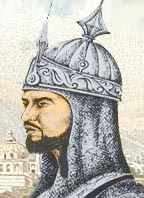
Back أشرف الهوتكي Arabic اشرف شاه هوتاكى ARZ Əşrəf şah Azerbaijani اشرف افغان AZB Ашраф Гатак BE-X-OLD আশরাফ হুতাক Bengali/Bangla Àixraf Khan Catalan Aschraf Khan German Ασράφ Χοτάκ Greek Ashraf Kan Spanish
| Shah Ashraf Hotak شاه اشرف هوتک | |||||
|---|---|---|---|---|---|
 | |||||
| Shah of Iran | |||||
| Reign | 22 April 1725 – 5 October 1729 | ||||
| Coronation | 22 April 1725, Isfahan | ||||
| Predecessor | Mahmud Hotak | ||||
| Successor | Tahmasp II | ||||
| Born | c. 1700 Kandahar Province, Safavid Iran | ||||
| Died | c. 1730 Balochistan, Hotak dynasty | ||||
| |||||
| Dynasty | Hotak dynasty | ||||
| Father | Abdul Aziz Hotak[2] | ||||
| Religion | Sunni Islam | ||||
Shāh Ashraf Hotak, (Pashto/Persian: شاه اشرف هوتک; died 1730), also known as Shāh Ashraf Ghiljī (شاه اشرف غلجي), son of Abdul Aziz Hotak, was the fourth ruler of the Hotak dynasty. An Afghan from the Ghilji Pashtuns, he served as a commander in the army of Mahmud Hotak during his revolt against the heavily declining Safavid Persians. Ashraf also participated in the Battle of Gulnabad. In 1725, he briefly succeeded to the throne to become Shah of Persia after he killed his cousin Mahmud.
The nephew of Mirwais Hotak, his reign was noted for the sudden decline in the Hotak tribal rule under increasing pressure from the two great powers of the time Turkish, Russian, and Persian forces.[3]
Ashraf Khan halted both the Russian and Turkish onslaughts. In the Ottoman-Hotaki War, He defeated the Ottoman Empire, who wanted to reestablish their former arch rivals, the Safavids, back on the throne, in a battle near Kermanshah. This led to peace negotiations with the Sublime Porte, which were briefly disrupted after Ashraf's ambassador insisted his master should be Caliph of the East and the Ottoman Sultan Caliph of the West. This caused great umbrage to the Ottomans, but a peace agreement was finally signed (Treaty of Hamedan) in October 1727.[4]

Ultimately, the royal Persian army of Shah Tahmasp II (one of the Shah Sultan Husayn's sons) under the leadership of Nader defeated Ashraf's Ghilji forces in a decisive battle known as the Battle of Damghan in October 1729, banishing and driving out the Afghans back to what is now Afghanistan.[3]
- ^ Mujtaba, Bahaudin Ghulam; Sayed Tayeb Jawad (2006). Afghanistan: Realities of War and Rebuilding. Ilead Academy. p. 10. ISBN 978-0-9774211-1-4. Retrieved 2010-08-22.
- ^ Vogelsang, Willem (2002). The Afghans. Wiley Blackwell. p. 224. ISBN 0-631-19841-5. Retrieved 2010-08-22.
- ^ a b "AN OUTLINE OF THE HISTORY OF PERSIA DURING THE LAST TWO CENTURIES (A.D. 1722–1922)". Edward Granville Browne. London: Packard Humanities Institute. p. 31. Retrieved 2010-09-24.
- ^ Jonas Hanway, The Revolutions of Persia (1753), p.254.